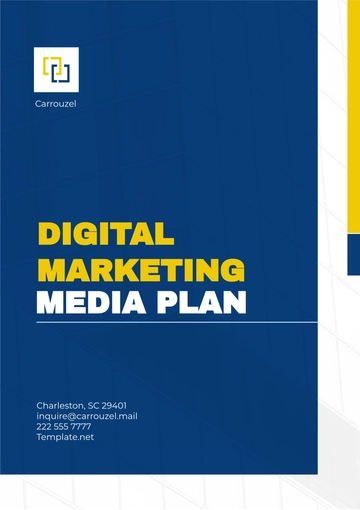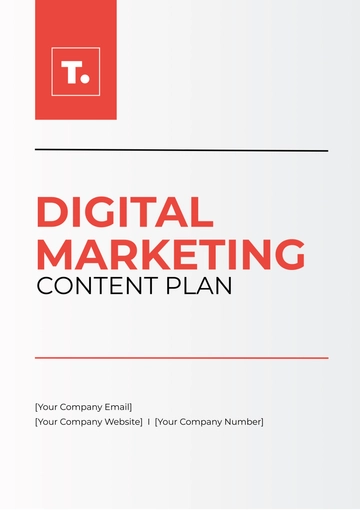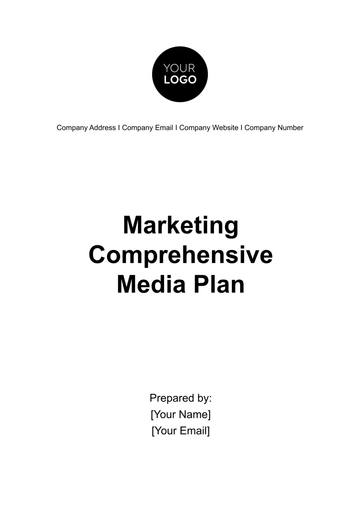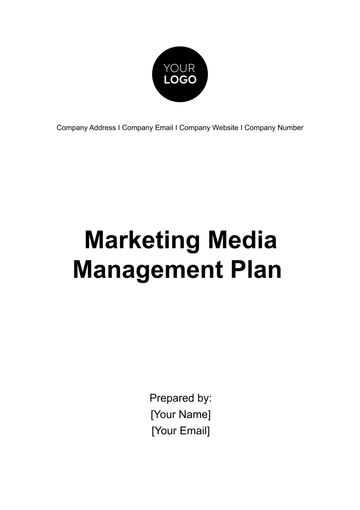Free Marketing Channel Plan

1. Introduction
The Marketing Channel Plan serves as a comprehensive and strategic document designed to guide [Your Company Name]'s marketing efforts across multiple channels for the upcoming fiscal year. The primary aim is to maximize both reach and return on investment (ROI) through a meticulous selection of marketing channels that resonate with our target audience. This plan is structured to integrate seamlessly with the overall marketing and business goals of [Your Company Name], thereby acting as a key component of our broader marketing strategy.
To achieve this, the plan provides an in-depth analysis of various channel selection criteria including their potential reach, cost-effectiveness, alignment with our target demographic, and expected ROI. Each selected channel is further evaluated and budgeted for, with clearly defined objectives and key performance indicators (KPIs) to measure success. By doing so, we intend to create a data-backed, actionable roadmap that ensures effective brand promotion, customer engagement, and ultimately, business growth.
By adhering to this plan, [Your Company Name] aims to establish a robust marketing ecosystem that is agile, measurable, and aligned with our organizational goals. This document serves as the foundational guide for all stakeholders involved in marketing decisions, ensuring a unified and purpose-driven approach to reaching our audience.
2. Objectives
Maximize Reach. The primary objective of this plan is to maximize the reach of [Your Company Name]'s marketing campaigns. This involves a thorough analysis of various channels to identify those that offer the broadest and most targeted access to our key customer demographics. The reach will be measured using metrics such as impressions, views, and engagement rates.
Optimize ROI. Return on Investment (ROI) is a critical indicator of a channel's performance and the effectiveness of our marketing strategy as a whole. We aim to leverage channels that offer the highest ROI based on criteria such as customer acquisition costs, customer lifetime value, and direct sales generated through each channel. Regular ROI analysis will be conducted to ensure ongoing effectiveness.
Alignment with Target Demographics. Each marketing channel should effectively target a specific customer demographic. This plan outlines the segmentation of our broader audience into more targeted groups based on age, geography, preferences, and behaviors. Channels will be selected and tailored to resonate with these targeted groups.
Seamless Integration with Overall Marketing Strategy. The Marketing Channel Plan is not an isolated document but a component of [Your Company Name]'s overarching marketing strategy. As such, it will integrate seamlessly with our objectives in other areas such as branding, customer engagement, and sales to create a cohesive marketing effort across all fronts.
Establish Measurable KPIs. The effectiveness of the plan will be gauged through Key Performance Indicators (KPIs). These KPIs will vary by channel but may include metrics such as click-through rates, conversion rates, and customer retention rates. These measurements will provide the data needed for ongoing optimization.
By achieving these objectives, [Your Company Name] will create a more effective and efficient marketing machine, designed to drive brand awareness, engage customers, and promote business growth. This sets the stage for the subsequent chapters, which will delve into the specifics of channel selection, budget allocation, implementation, and monitoring.
3. Target Audience
Understanding the target audience is crucial for selecting the most effective marketing channels and crafting messages that resonate. This chapter outlines the key demographics that [Your Company Name] aims to reach, based on an amalgamation of market research, past sales data, and customer behavior analysis. The goal is to provide a detailed profile that serves as the basis for all subsequent channel selection and marketing activities.
Demographic Factor | Description | Relevance to Channel Selection |
Age | 25-45 years old | Channels should be popular among this age group. |
Income | Annual income between $40,000 and $100,000 | Aligns with the price point of our products/services. |
Interests | Technology, Fitness, Sustainable Living | Channels should cater to these interests or communities around them. |
4. Channel Selection Criteria
Choosing the right marketing channels is a pivotal aspect of any successful marketing strategy. The selection process needs to be data-driven, focused, and aligned with both the target audience and the overall business goals. In this chapter, we delve into the primary criteria that [Your Company Name] uses for selecting appropriate marketing channels. These criteria are designed to ensure that each channel not only reaches our intended audience but does so in a cost-effective manner, with a focus on achieving the best possible return on investment (ROI).
Reach. The term 'reach' refers to the number of people that can potentially be exposed to our marketing messages through a given channel. The greater the reach, the higher the chances of achieving our marketing objectives. However, it's not just about sheer numbers; the quality of the reach, meaning how well the audience aligns with our target demographic, is equally important. Channels with high reach include mainstream social media platforms like Facebook and Instagram, as well as popular search engines like Google.
Cost-effectiveness. Every channel comes with its own set of costs—be it time, money, or resources. Cost-effectiveness is a measure of how well the channel can achieve its goals relative to the investment required. For example, organic search might take longer to show results but offers cost-effective, long-term benefits. On the other hand, pay-per-click (PPC) advertising may offer quick wins but could become expensive in the long run. We aim to find a balance by mixing high-cost, high-reward channels with those that offer steady returns over time.
Alignment with Target Audience. Alignment with the target audience is perhaps the most crucial criterion. There's no point in investing in a channel if it doesn't cater to the demographic profile we aim to target. This involves understanding the audience’s habits, preferences, and behaviors as they relate to the selected marketing channel. For instance, if our target audience is primarily interested in technology, channels like tech blogs, LinkedIn, and specialized tech forums might be more effective than generic platforms.
ROI Potential. The end goal of any marketing activity is to achieve a high ROI. This involves not only direct financial returns but also gains in brand awareness, customer loyalty, and other intangible assets. Channels are assessed for their potential to meet or exceed specific KPIs that align with our overarching business objectives. Metrics such as conversion rate, customer lifetime value, and net promoter score are often considered when evaluating the ROI potential of a channel.
By meticulously analyzing each channel against these criteria, [Your Company Name] aims to develop a robust, scalable, and effective marketing channel strategy.
5. Marketing Channel Overview
Navigating the myriad of available marketing channels can be a daunting task. Each channel comes with its unique set of strengths, weaknesses, and requirements. In this chapter, we present a curated overview of the key marketing channels that [Your Company Name] has decided to leverage for the upcoming fiscal year. We break down the channels based on their primary objectives, budget allocations, and the metrics by which their performance will be evaluated. This overview serves as a snapshot of our comprehensive marketing channel strategy, providing stakeholders with essential details for effective implementation and monitoring.
By carefully allocating budgets and setting realistic, measurable goals for each channel, we aim to create a well-rounded and effective marketing strategy. Each channel has been selected based on its alignment with our target audience and its ability to meet specific objectives, be it brand awareness, traffic generation, customer retention, or sales conversion. By focusing on these key metrics, we intend to ensure accountability, track performance, and, ultimately, achieve our marketing and business goals.
Channel | Objective | Budget | Metrics |
Social Media | Brand Awareness | $10,000 | Engagement, Reach |
SEO | Traffic Generation | $8,000 | Organic Traffic, Bounce Rate |
Email Marketing | Customer Retention | $5,000 | Open Rate, Click-Through Rate |
PPC Ads | Sales Conversion | $7,000 | Conversion Rate, CPC |
6. Budget
Budgeting is the backbone of any successful marketing plan, acting as both a guide and a constraint for your various marketing activities. This chapter offers a detailed breakdown of the budget allocated for each marketing channel [Your Company Name] will utilize in the upcoming fiscal year. Here, we outline the financial commitment for Social Media, SEO, Email Marketing, and PPC Ads, tallying up to a total budget of $30,000.
In allocating these funds, we have taken into account the expected return on investment (ROI), alignment with our target audience, and the overall objectives set for each channel. The budget serves as a financial roadmap, helping the marketing team and other stakeholders understand where resources will be focused. This not only aids in efficient fund allocation but also serves as a tool for performance measurement, as overspending or underspending can be an indicator of strategy effectiveness or misalignment. Through careful budget planning, we aim to maximize impact while minimizing costs, striving for an optimized marketing strategy that drives tangible results.
Channel | Budget Allocation |
Social Media | $10,000 |
SEO | $8,000 |
Email Marketing | $5,000 |
PPC Ads | $7,000 |
Total | $30,000 |
7. Execution Timeline
Time management is essential for the effective execution of any marketing plan. This chapter presents the Execution Timeline, a chronological blueprint that delineates key milestones and deadlines that [Your Company Name] aims to achieve in the year 2024. By outlining crucial steps such as the completion of initial research, channel selection, budget finalization, and the campaign launch, we provide a structured framework that guides all stakeholders in the marketing process.
The timeline is meticulously designed to ensure that each phase of our marketing channel strategy is executed in a timely manner, allowing for appropriate planning, resource allocation, and review. It aims to keep the marketing team, as well as any other key departments or stakeholders, aligned and informed about what needs to happen and when. This sequential roadmap aids in tracking progress, identifying bottlenecks, and making necessary adjustments to ensure we meet our marketing objectives efficiently and effectively.
Date [MM/YYYY] | Milestone |
[01/2024] | Initial Research Complete |
[02/2024] | Channel Selection |
[03/2024] | Budget Finalized |
[04/2024] | Campaign Launch |
8. KPIs and Metrics
The success of any marketing strategy hinges on the ability to measure and analyze its impact. This chapter focuses on the Key Performance Indicators (KPIs) and Metrics that [Your Company Name] will use to evaluate the effectiveness of the chosen marketing channels. By setting these benchmarks, we aim to quantify the performance of our campaigns, thereby providing valuable data that can be leveraged for continuous improvement and strategic decision-making.
Social Media: Engagement Rate, Follower Count
Engagement Rate measures the level of interaction that content receives on social media platforms. It's a crucial metric for understanding how well our content resonates with our audience. A high engagement rate usually indicates a strong connection with the target audience and can also lead to higher organic reach. Follower Count, on the other hand, provides a numerical value that signifies the size of the audience we have directly accessible on the platform. While it's not a direct indicator of engagement or sales, a high follower count augments the brand's credibility and reach.
SEO: Organic Traffic, Keyword Rankings
Organic Traffic refers to the number of visitors coming to our website through unpaid search results. Higher organic traffic often signifies that the website has valuable content and is viewed as an authority in its field. Keyword Rankings indicate the position of our website in search engine results for specific keywords that are crucial to our business. Achieving high rankings for targeted keywords can significantly increase organic traffic, thereby reducing the dependency on paid advertising.
Email Marketing: Open Rates, Click-Through Rates
Open Rates measure the percentage of recipients who have opened an email. This metric serves as an initial indicator of how engaging our email campaigns are and can help us fine-tune subject lines or timing for future campaigns. Click-Through Rates (CTR) indicate the percentage of email recipients who clicked on one or more links contained in an email. A high CTR usually means that the email content is relevant to the audience and encourages them to take action, such as visiting a webpage or making a purchase.
PPC Ads: Conversion Rate, Cost Per Conversion
Conversion Rate in the context of Pay-Per-Click (PPC) advertising measures the percentage of clicks that result in a defined action, such as a sale or a signup. It’s a critical metric to understand how effective the PPC ads are at encouraging users to take the desired action. Cost Per Conversion tells us how much we have spent to acquire each conversion. Lowering this cost while maintaining or improving conversion rates is generally the aim, as it indicates a higher ROI for the advertising spend.
9. Reporting and Analysis
The significance of continuous evaluation in the ever-changing marketing landscape cannot be overstated. To that end, [Your Company Name] will generate monthly performance reports that scrutinize the effectiveness of each marketing channel against the established Key Performance Indicators (KPIs) and metrics. These reports serve multiple vital functions.
First, they provide a structured way to measure the ROI for each channel, informing us whether our investments are yielding the expected results or need readjustment. Second, they offer actionable insights into consumer behavior, channel effectiveness, and market trends, thereby facilitating data-driven decisions for future marketing initiatives. Third, these reports create a platform for internal communication, making it easier to align various departments with the company's overarching marketing goals and strategies.
By setting a standard monthly schedule for reporting, we ensure consistency and create a historical data set that can be used for year-over-year comparisons and long-term strategic planning. Moreover, the monthly frequency strikes the right balance between being frequent enough to make timely adjustments and spaced enough to analyze patterns and trends meaningfully.
In summary, monthly performance reports are not just a review mechanism but a strategic tool designed to continuously refine and optimize [Your Company Name]'s multi-channel marketing approach. They will be critical in identifying successes, isolating shortcomings, and developing strategies for ongoing and future campaigns.
10. Conclusion
In a complex and ever-changing marketplace, having a comprehensive and well-thought-out Marketing Channel Plan is crucial for sustained business growth. This document functions as the master blueprint that will guide all of [Your Company Name]'s marketing activities for the upcoming fiscal year. It has been meticulously crafted to align with our target audience, business objectives, and budgetary constraints, all the while placing a strong emphasis on maximizing the return on investment (ROI). By diligently adhering to the strategies, timelines, and metrics outlined in this plan, we not only aim to meet our business objectives but also to exceed them. This plan also ensures that all stakeholders have a unified roadmap, contributing to a more coherent and effective marketing strategy. Overall, the implementation of this Marketing Channel Plan is a critical step in achieving a competitive edge, fostering customer engagement, and driving business success for [Your Company Name].
_____________________________________________________________________________________
Prepared By: [Your Name]
Contact: [Your Contact Information]
Date: [Current Date]
_____________________________________________________________________________________
For any further queries or clarifications, please contact [Your Name] at [Your Contact Information].
- 100% Customizable, free editor
- Access 1 Million+ Templates, photo’s & graphics
- Download or share as a template
- Click and replace photos, graphics, text, backgrounds
- Resize, crop, AI write & more
- Access advanced editor
Discover the ultimate marketing companion at Template.net! Our Marketing Channel Plan Template is your key to strategic success. Fully editable and customizable in our Ai Editor Tool, this comprehensive template empowers businesses of all sizes to craft coherent, data-driven campaigns for maximum reach and ROI. Elevate your marketing strategy today!
You may also like
- Finance Plan
- Construction Plan
- Sales Plan
- Development Plan
- Career Plan
- Budget Plan
- HR Plan
- Education Plan
- Transition Plan
- Work Plan
- Training Plan
- Communication Plan
- Operation Plan
- Health And Safety Plan
- Strategy Plan
- Professional Development Plan
- Advertising Plan
- Risk Management Plan
- Restaurant Plan
- School Plan
- Nursing Home Patient Care Plan
- Nursing Care Plan
- Plan Event
- Startup Plan
- Social Media Plan
- Staffing Plan
- Annual Plan
- Content Plan
- Payment Plan
- Implementation Plan
- Hotel Plan
- Workout Plan
- Accounting Plan
- Campaign Plan
- Essay Plan
- 30 60 90 Day Plan
- Research Plan
- Recruitment Plan
- 90 Day Plan
- Quarterly Plan
- Emergency Plan
- 5 Year Plan
- Gym Plan
- Personal Plan
- IT and Software Plan
- Treatment Plan
- Real Estate Plan
- Law Firm Plan
- Healthcare Plan
- Improvement Plan
- Media Plan
- 5 Year Business Plan
- Learning Plan
- Marketing Campaign Plan
- Travel Agency Plan
- Cleaning Services Plan
- Interior Design Plan
- Performance Plan
- PR Plan
- Birth Plan
- Life Plan
- SEO Plan
- Disaster Recovery Plan
- Continuity Plan
- Launch Plan
- Legal Plan
- Behavior Plan
- Performance Improvement Plan
- Salon Plan
- Security Plan
- Security Management Plan
- Employee Development Plan
- Quality Plan
- Service Improvement Plan
- Growth Plan
- Incident Response Plan
- Basketball Plan
- Emergency Action Plan
- Product Launch Plan
- Spa Plan
- Employee Training Plan
- Data Analysis Plan
- Employee Action Plan
- Territory Plan
- Audit Plan
- Classroom Plan
- Activity Plan
- Parenting Plan
- Care Plan
- Project Execution Plan
- Exercise Plan
- Internship Plan
- Software Development Plan
- Continuous Improvement Plan
- Leave Plan
- 90 Day Sales Plan
- Advertising Agency Plan
- Employee Transition Plan
- Smart Action Plan
- Workplace Safety Plan
- Behavior Change Plan
- Contingency Plan
- Continuity of Operations Plan
- Health Plan
- Quality Control Plan
- Self Plan
- Sports Development Plan
- Change Management Plan
- Ecommerce Plan
- Personal Financial Plan
- Process Improvement Plan
- 30-60-90 Day Sales Plan
- Crisis Management Plan
- Engagement Plan
- Execution Plan
- Pandemic Plan
- Quality Assurance Plan
- Service Continuity Plan
- Agile Project Plan
- Fundraising Plan
- Job Transition Plan
- Asset Maintenance Plan
- Maintenance Plan
- Software Test Plan
- Staff Training and Development Plan
- 3 Year Plan
- Brand Activation Plan
- Release Plan
- Resource Plan
- Risk Mitigation Plan
- Teacher Plan
- 30 60 90 Day Plan for New Manager
- Food Safety Plan
- Food Truck Plan
- Hiring Plan
- Quality Management Plan
- Wellness Plan
- Behavior Intervention Plan
- Bonus Plan
- Investment Plan
- Maternity Leave Plan
- Pandemic Response Plan
- Succession Planning
- Coaching Plan
- Configuration Management Plan
- Remote Work Plan
- Self Care Plan
- Teaching Plan
- 100-Day Plan
- HACCP Plan
- Student Plan
- Sustainability Plan
- 30 60 90 Day Plan for Interview
- Access Plan
- Site Specific Safety Plan





























